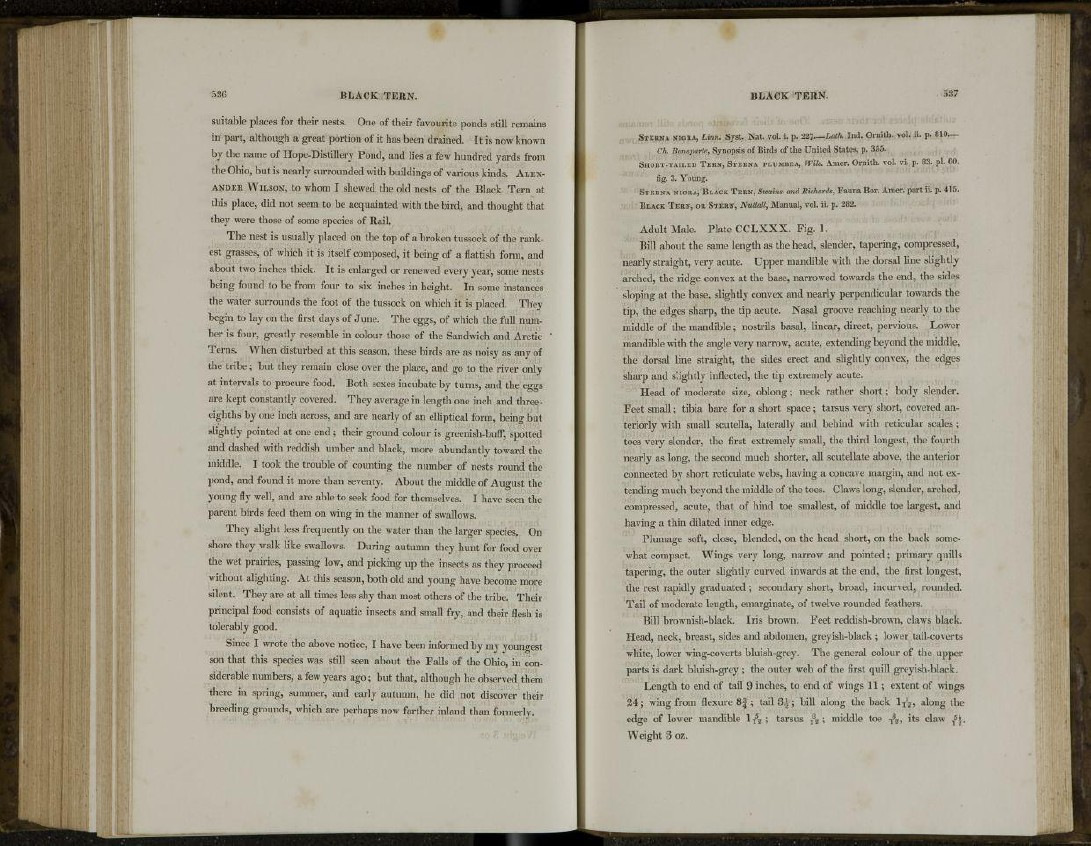
536 BLACK TERN.
suitable places for their nests. One of their favourite ponds still remains
in part, although a great portion of it has been drained. It is now known
by the name of Hope-Distillery Pond, and lies a few hundred yards from
the Ohio, but is nearly surrounded with buildings of various kinds. ALEXANDER
WILSON, to whom I shewed the old nests of the Black Tern at
this place, did not seem to be acquainted with the bird, and thought that
they were those of some species of Rail.
The nest is usually placed on the top of a broken tussock of the rankest
grasses, of which it is itself composed, it being of a flattish form, and
about two inches thick. It is enlarged or renewed every year, some nests
being found to be from four to six inches in height. In some instances
the water surrounds the foot of the tussock on which it is placed. They
begin to lay on the first days of June. The eggs, of which the full number
is four, greatly resemble in colour those of the Sandwich and Arctic
Terns. When disturbed at this season, these birds are as noisy as any of
the tribe; but they remain close over the place, and go to the river only
at intervals to procure food. Both sexes incubate by turns, and the eggs
are kept constantly covered. They average in length one inch and threeeighths
by one inch across, and are nearly of an elliptical form, being but
slightly pointed at one end; their ground colour is greenish-buff, spotted
and dashed with reddish umber and black, more abundantly toward the
middle. I took the trouble of counting the number of nests round the
pond, and found it more than seventy. About the middle of August the
young fly well, and are able to seek food for themselves. I have seen the
parent birds feed them on wing in the manner of swallows.
They alight less frequently on the water than the larger species. On
shore they walk like swallows. During autumn they hunt for food over
the wet prairies, passing low, and picking up the insects as they proceed
without alighting. At this season, both old and young have become more
silent. They are at all times less shy than most others of the tribe. Their
principal food consists of aquatic insects and small fry, and their flesh is
tolerably good.
Since I wrote the above notice, I have been informed by my youngest
son that this species was still seen about the Falls of the Ohio, in considerable
numbers, a few years ago; but that, although he observed them
there in spring, summer, and early autumn, he did not discover their
breeding grounds, which are perhaps now farther inland than formerly.
BLACK TERN. 537
STERNA NIGRA, Linn. Syst Nat. vol. i. p. 227—Lath. Ind. Ornith. vol. ii. p. 810—
Ch. Bonaparte, Synopsis of Birds of the United States, p. 355.
SHORT-TAILED TERN, STERNA PLUMBEA, Wils. Amer. Ornith. vol. vi. p. 83. pi. 60.
fig. 3. Young.
STERNA NIGRA, BLACK TERN, Swains, and Richards, Fauna Bor. Amer. part ii. p. 415.
BLACK TERN, OR STERN, Nuttall, Manual, vol. ii. p. 282.
Adult Male. Plate CCLXXX. Fig. 1.
Bill about the same length as the head, slender, tapering, compressed,
nearly straight, very acute. Upper mandible with the dorsal line slightly
arched, the ridge convex at the base, narrowed towards the end, the sides
sloping at the base, slightly convex and nearly perpendicular towards the
tip, the edges sharp, the tip acute. Nasal groove reaching nearly to the
middle of the mandible; nostrils basal, linear, direct, pervious. Lower
mandible with the angle very narrow, acute, extending beyond the middle,
the dorsal line straight, the sides erect and slightly convex, the edges
sharp and slightly inflected, the tip extremely acute.
Head of moderate size, oblong; neck rather short; body slender.
Feet small; tibia bare for a short space; tarsus very short, covered anteriorly
with small scutella, laterally and behind with reticular scales ;
toes very slender, the first extremely small, the third longest, the fourth
nearly as long, the second much shorter, all scutellate above, the anterunconnected
by short reticulate webs, having a concave margin, and not extending
much beyond the middle of the toes. Claws long, slender, arched,
compressed, acute, that of hind toe smallest, of middle toe largest, and
having a thin dilated inner edge.
Plumage soft, close, blended, on the head short, on the back somewhat
compact. Wings very long, narrow and pointed; primary quills
tapering, the outer slightly curved inwards at the end, the first longest,
the rest rapidly graduated ; secondary short, broad, incurved, rounded.
Tail of moderate length, emarginate, of twelve rounded feathers.
Bill brownish-black. Iris brown. Feet reddish-brown, claws black.
Head, neck, breast, sides and abdomen, greyish-black ; lower tail-coverts
white, lower wing-coverts bluish-grey. The general colour of the upper
parts is dark bluish-grey ; the outer web of the first quill greyish-black.
Length to end of tail 9 inches, to end of wings 11 ; extent of wings
24; wing from flexure 8f ; tail 3,^ ; bill along the back l ^ j , along the
edge of lower mandible 15
2 ; tarsus 8
2 ; middle toe 8
, its claw H.
T
T
x
2 Weight 3 oz.